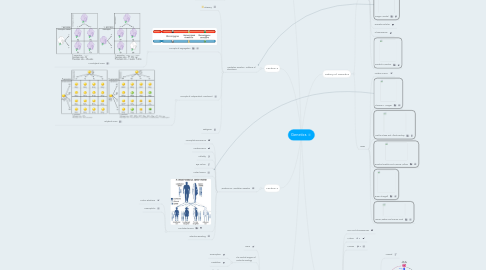
1. History of Genetics
1.1. 1800s
1.1.1. Cells Contain Genetic Material
1.1.2. Charles Darwin and Alfred Russel Wallace
1.1.3. Jean-Baptiste Lamarck
1.1.4. Gregor Mendel
1.1.5. Discrete Particles
1.1.6. Chromosomes
1.1.7. Friedrich Miescher
1.2. 1950s
1.2.1. Protein vs DNA
1.2.2. Thomas H. Morgan
1.2.3. Martha Chase and Alfred Hershey
1.2.4. Rosalind Franklin and Maurice Wilkins
1.2.5. Erwin Chargaff
1.2.6. James Watson and Francis Crick
2. Lecture 1
2.1. DNA and Chromosomes
2.2. Mitosis
2.3. Meiosis
2.4. Asexual vs Sexual Reproduction
2.4.1. Asexual
2.4.2. Sexual
2.5. Cancer
2.5.1. Benign Tumour
2.5.1.1. Treatment
2.5.1.1.1. Surgery
2.5.2. Malignant Tumour
2.5.2.1. Treatment
2.5.2.1.1. Slash
2.5.2.1.2. Burn
2.5.2.1.3. Poison
2.5.3. Causes and Prevention
2.5.3.1. Genetic Factors
2.5.3.2. Environmental Factors
3. Lecture 2
3.1. Variation
3.1.1. Mutations
3.1.1.1. Chromosomal Mutations
3.1.1.2. Gene Mutations
3.1.1.2.1. Insertion
3.1.1.2.2. Deletion
3.1.1.2.3. Substitution
3.1.2. Sexual Reproduction
3.1.2.1. Crossing Over
3.1.2.2. Independent Assortment
3.1.2.3. Random Fertilisation
3.2. Errors in Meiosis
3.2.1. Non-dysjunction
3.2.1.1. Aneuploidy
3.2.1.1.1. Meiotic Non-dysjunction
3.2.1.1.2. Mitotic Non-dysjunction
3.2.2. Polyploidy
3.2.2.1. Triploidy
3.2.2.2. Tetraploidy
3.2.3. Evolutionary Connection
4. Lecture 3
4.1. Mendelian Genetics - Patterns of Inheritance
4.1.1. Glossary
4.1.2. Principle of Segregation
4.1.2.1. Monohybrid Cross
4.1.3. Principle of Independent Assortment
4.1.3.1. Dihybrid Cross
4.1.4. Pedigrees
5. Lecture 4
5.1. Variations on Mendelian Genetics
5.1.1. Incomplete Dominance
5.1.2. Codominance
5.1.3. Lethality
5.1.4. Eye Colour
5.1.5. Linked Genes
5.1.6. Sex-linked Genes
5.1.6.1. Colour Blindness
5.1.6.2. Haemophilia
5.1.7. Selective Breeding
6. Lecture 5
6.1. Gene
6.2. The Central Dogma of Molecular Biology
6.2.1. Transcription
6.2.2. Translation
6.3. Mutations
6.3.1. Sickle Cell Disease
6.3.2. Gene or point mutation
6.3.2.1. Base Substitution
6.3.2.2. Frameshift Mutations
6.3.2.2.1. Base Deletion
6.3.2.2.2. Base Insertion
6.3.3. Mutagens
6.3.3.1. Genetic Factors
6.3.3.2. Environmental Factors
6.4. The Genetic Potential of Cells
6.4.1. Agriculture
6.4.2. Reproductive Cloning/Nuclear Transplantation
6.4.3. Stem Cells
6.4.3.1. Adult Stem Cells
6.4.3.2. Umbilical Stem Cells
6.5. Uses For Studying Genetics
6.5.1. DNA Technology
6.5.2. Genetic Engineering
6.5.2.1. Pharm Organisms
6.5.3. Forensic Science
6.5.4. De-extinction
6.5.5. Evolution and the Human Genome
